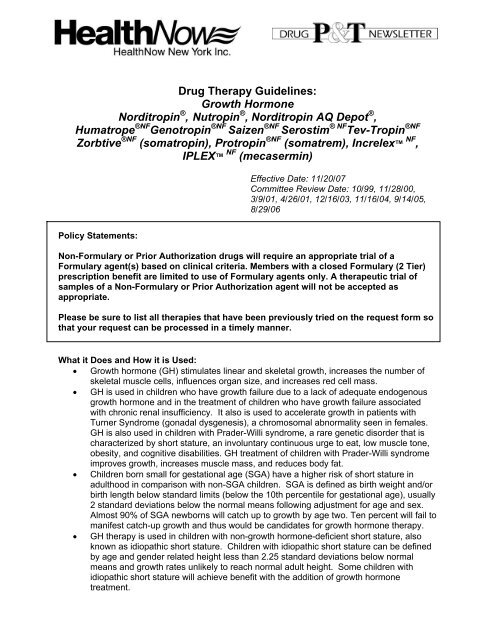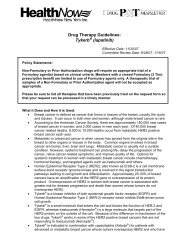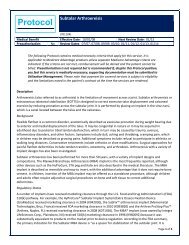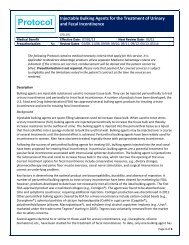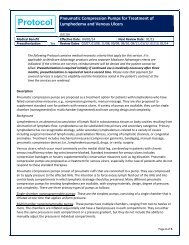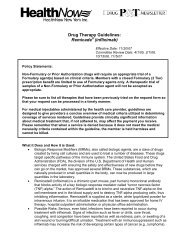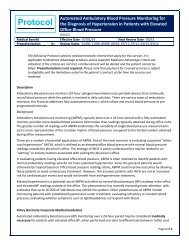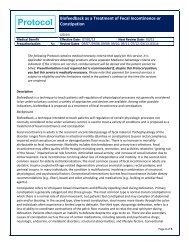Drug Therapy Guidelines: Growth Hormone Norditropin , Nutropin ...
Drug Therapy Guidelines: Growth Hormone Norditropin , Nutropin ...
Drug Therapy Guidelines: Growth Hormone Norditropin , Nutropin ...
You also want an ePaper? Increase the reach of your titles
YUMPU automatically turns print PDFs into web optimized ePapers that Google loves.
<strong>Drug</strong> <strong>Therapy</strong> <strong>Guidelines</strong>:<br />
<strong>Growth</strong> <strong>Hormone</strong><br />
<strong>Norditropin</strong> ® , <strong>Nutropin</strong> ® , <strong>Norditropin</strong> AQ Depot ® ,<br />
Humatrope ®NF Genotropin ®NF Saizen ®NF Serostim ® NF Tev-Tropin ®NF<br />
Zorbtive ®NF (somatropin), Protropin ®NF (somatrem), Increlex NF ,<br />
IPLEX NF (mecasermin)<br />
Effective Date: 11/20/07<br />
Committee Review Date: 10/99, 11/28/00,<br />
3/9/01, 4/26/01, 12/16/03, 11/16/04, 9/14/05,<br />
8/29/06<br />
Policy Statements:<br />
Non-Formulary or Prior Authorization drugs will require an appropriate trial of a<br />
Formulary agent(s) based on clinical criteria. Members with a closed Formulary (2 Tier)<br />
prescription benefit are limited to use of Formulary agents only. A therapeutic trial of<br />
samples of a Non-Formulary or Prior Authorization agent will not be accepted as<br />
appropriate.<br />
Please be sure to list all therapies that have been previously tried on the request form so<br />
that your request can be processed in a timely manner.<br />
What it Does and How it is Used:<br />
• <strong>Growth</strong> hormone (GH) stimulates linear and skeletal growth, increases the number of<br />
skeletal muscle cells, influences organ size, and increases red cell mass.<br />
• GH is used in children who have growth failure due to a lack of adequate endogenous<br />
growth hormone and in the treatment of children who have growth failure associated<br />
with chronic renal insufficiency. It also is used to accelerate growth in patients with<br />
Turner Syndrome (gonadal dysgenesis), a chromosomal abnormality seen in females.<br />
GH is also used in children with Prader-Willi syndrome, a rare genetic disorder that is<br />
characterized by short stature, an involuntary continuous urge to eat, low muscle tone,<br />
obesity, and cognitive disabilities. GH treatment of children with Prader-Willi syndrome<br />
improves growth, increases muscle mass, and reduces body fat.<br />
• Children born small for gestational age (SGA) have a higher risk of short stature in<br />
adulthood in comparison with non-SGA children. SGA is defined as birth weight and/or<br />
birth length below standard limits (below the 10th percentile for gestational age), usually<br />
2 standard deviations below the normal means following adjustment for age and sex.<br />
Almost 90% of SGA newborns will catch up to growth by age two. Ten percent will fail to<br />
manifest catch-up growth and thus would be candidates for growth hormone therapy.<br />
• GH therapy is used in children with non-growth hormone-deficient short stature, also<br />
known as idiopathic short stature. Children with idiopathic short stature can be defined<br />
by age and gender related height less than 2.25 standard deviations below normal<br />
means and growth rates unlikely to reach normal adult height. Some children with<br />
idiopathic short stature will achieve benefit with the addition of growth hormone<br />
treatment.
• GH therapy is used for adults with childhood onset growth hormone deficiency, pituitary<br />
or hypothalamic disease, or growth hormone deficiency due to surgery, radiation<br />
therapy or previous trauma. Adult growth hormone deficiency is characterized by<br />
increased weight and body fat mass, decreased lean body mass, decreased exercise<br />
capacity, decreased muscle mass and strength, reduced cardiac performance, reduced<br />
bone density, and impaired sense of well-being. In adults, the goals of GH therapy are<br />
to restore normal body composition, improve muscle and cardiac function, normalize<br />
serum lipid concentrations, and improve the quality of life.<br />
• Short bowel syndrome is a rare condition affecting approximately 10,000 – 20,000<br />
patients. These patients are most often dependent on supplemental intravenous<br />
feedings for nutritional support. Short-bowel syndrome results from having a significant<br />
amount of small intestine removed during surgery. Conditions such as insufficient blood<br />
flow to the GI tract, intestinal obstruction, or Crohn’s disease may warrant the removal<br />
of intestines. GH therapy is used in the management of short bowel syndrome patients<br />
to decrease the need for intravenous nutritional support by increasing the bowel’s ability<br />
to absorb nutrients from oral intake. Patients with short bowel syndrome are assessed<br />
for treatment benefit after four weeks of GH therapy.<br />
• Serostim® is used for the treatment of AIDS-related cachexia or wasting. GH has been<br />
shown to increase lean body mass and decrease fat mass in patients with AIDS.<br />
• Other conditions for which there is insufficient information to support the use of GH<br />
include:<br />
a) Constitutional delay of growth, which is characterized by normal prenatal<br />
growth followed by growth deceleration during infancy and childhood. In<br />
general, these patients can achieve normal adult height if no treatment is given.<br />
b) To delay or reverse the aging process in older adults<br />
c) Adjunct to infertility treatment<br />
d) Treatment of burn injuries<br />
e) Treatment of obesity<br />
• GH is administered subcutaneously or intramuscularly one to six times weekly for all<br />
indications other than short bowel syndrome, in which it is administered daily.<br />
• In healthy children, GH is secreted into the bloodstream and acts to stimulate<br />
production of IGF-1. IGF-1 is the main hormone responsible for carrying out the effects<br />
of GH, and it must be present in order for children’s bones, cartilage, and organs to<br />
grow normally. In primary IGF-1 deficiency, GH levels are not low, but rather, cells are<br />
unable to produce adequate IGF-1 in response to GH stimulation. Primary IGF-1<br />
deficiency is caused by any defect in the process of IGF-1 production.<br />
• Increlex (recombinant human IGF-1) is used in children who have growth failure due<br />
to severe primary IGF-1 deficiency. Primary IGF-1 deficiency affects approximately<br />
30,000 children with short stature in the United States, and 6,000 of these children have<br />
severe primary IGF-1 deficiency. Severe primary IGF-1 deficiency is characterized in<br />
children with height and serum IGF-1 levels ≥3 standard deviations below normal in the<br />
presence of normal or elevated GH levels.<br />
• IGF-1 is being investigated for use in the treatment of less severe forms of primary IGF-<br />
1 deficiency and in the treatment of severe insulin-resistant diabetes.<br />
• Increlex is administered subcutaneously twice daily for severe primary IGF-1<br />
deficiency.<br />
Note: sermorelin (Geref® Diagnostic) is used for GH deficiency testing only and not for the<br />
treatment of GH deficiency.
What it Costs:<br />
Agent Patient Group AWP<br />
<strong>Growth</strong> <strong>Hormone</strong> Pediatrics $13,000 - $30,000 (Annual)<br />
<strong>Growth</strong> <strong>Hormone</strong> Adults $12,000 - $15,000 (Annual)<br />
Zorbtive ® Short Bowel Syndrome Patients $21,504 (one 4-wk course)<br />
Serostim ® AIDS Wasting Patients $5,000 - $7,500 (Monthly)<br />
Increlex Severe Primary IGF-1 Deficiency $12,000 - $50,000 (Annual)<br />
IPLEX Severe Primary IGF-1 Deficiency $32,000 - $99,000 (Annual)<br />
Rationale for Prior Authorization:<br />
To reduce exposure to cost associated with use of growth hormone or IGF-1 for conditions for<br />
which its effectiveness is not known (e.g., treatment of constitutional delayed growth, infertility,<br />
severe insulin-resistant diabetes, or less severe forms of primary IGF-1 deficiency). <strong>Growth</strong><br />
hormone therapy is not covered for use in reversing or delaying the aging process.<br />
Benefit Design:<br />
Coverage is determined through a prior authorization process for every claim.<br />
Prior Authorization Criteria:<br />
Coverage is provided for pediatric growth hormone deficiency in the presence of the<br />
following:<br />
• patient’s height must be below the third percentile for their age and gender related<br />
height<br />
• growth velocity subnormal ≥ 2 standard deviations from the age related mean<br />
• delayed skeletal maturation ≥ 2 standard deviations below the age/gender related mean<br />
• epiphyses confirmed as open in patients ≥ 10 years of age<br />
• growth hormone deficiency confirmed by any 2 provocative tests OR by insulin growth<br />
factor-1 (IGF-1) a.k.a. somatomedin C, or IGF binding protein-3 (IGFBP-3) levels<br />
• a growth response of ≥ 4.5 cm/yr (pre-pubertal growth phase) or ≥ 2.5 cm/yr (postpubertal)<br />
must occur for continuation of coverage<br />
Coverage is provided for:<br />
• pediatric growth failure due to chronic renal failure (in situations where the patient has<br />
not undergone a renal transplant)<br />
• growth failure in children born small for gestational age (SGA) who fail to manifest catch<br />
up growth by age 2 defined as birth weight, birth length, or both that are more than 2<br />
standard deviations below mean normal values following adjustment for age and<br />
gender.<br />
• pediatric growth failure due to Turner’s syndrome (provocative tests not required)<br />
• treatment of Prader-Willi syndrome (provocative tests not required)<br />
Coverage is provided for idiopathic short stature (non-growth hormone-deficient short<br />
stature) in the presence of the following:<br />
• patient is under the care of a pediatric endocrinologist<br />
• patient is > 7 years of age<br />
• epiphyses are confirmed open in patients > 10 years of age<br />
• patient’s height is < -2.25 standard deviations from the mean<br />
• prescriber has determined that the patient does not have constitutional delay of growth<br />
Coverage is not provided for constitutional delayed growth.
Coverage is provided for adult growth hormone deficiency (in the presence of a growth<br />
hormone stimulation test) due to:<br />
• childhood onset growth hormone deficiency<br />
• pituitary or hypothalamic disease<br />
• surgery or radiation therapy<br />
• trauma<br />
Coverage is provided for the treatment of short bowel syndrome in patients receiving<br />
supplemental nutritional support.<br />
Coverage for Serostim® for the treatment of AIDS related cachexia in accord with the<br />
following:<br />
• patient ≥ 18 years of age<br />
• wasting syndrome not attributable to other causes such as; depression, MAC, chronic<br />
infectious diarrhea, or malignancy (Kaposi’s sarcoma limited to the skin or mucous<br />
membranes is covered)<br />
• confirmation of wasting syndrome (e.g., unintentional weight loss of ≥ 10% of body<br />
weight)<br />
• in situations where optimal antiretroviral therapy has been attempted<br />
Coverage for Increlex or Iplex is provided in accord with the following:<br />
• For the long-term treatment of growth failure in children with severe primary IGF-1<br />
deficiency or with growth hormone gene deletion who have developed neutralizing<br />
antibodies to growth hormone in the presence of the following:<br />
a) Patient’s height standard deviation score must be ≤ -3.0 AND<br />
b) The basal IGF-1 score must be below the lower limits of normal for the<br />
reporting lab AND<br />
c) The patient must have normal or elevated growth hormone (except for patients<br />
with growth hormone gene deletion) AND<br />
d) Epiphyses must be confirmed as open in patients ≥ 10 years of age.<br />
• Coverage is provided in situations where the diagnosis of primary IGF-1 deficiency has<br />
been made by an endocrinologist.<br />
• Coverage is not provided in the presence of:<br />
a) Concurrent treatment with growth hormone<br />
b) Pharmacologic doses of corticosteroids<br />
Coverage Duration:<br />
• Pediatric human growth hormone deficiency, growth failure in children SGA,<br />
growth failure due to Turner’s syndrome or chronic renal failure: benefit approved<br />
for 12 months and is renewable in the presence of open epiphyses and a growth<br />
response of ≥ 4.5 cm/yr (pre-pubertal growth rate) or ≥ 2.5 cm/yr (post-pubertal growth<br />
rate).<br />
• Idiopathic short stature (non-growth hormone-deficient short stature): benefit<br />
approved for 12 months and is renewable in the presence of open epiphyses and where<br />
growth velocity is ≥ 1.5 cm/year.<br />
• Adult growth hormone deficient syndrome: benefit approved for 6 months and is<br />
renewable in the presence of clinical benefit (e.g., increase in total lean body mass,<br />
increase in IGF-1 and IGFBP-3 levels, or increase in exercise capacity).<br />
• Short bowel syndrome: benefit approved for 1 month and is renewable in the<br />
presence of clinical benefit (e.g., a decrease in the patient’s intravenous nutritional<br />
requirements).
• AIDS related cachexia (Serostim® only): benefit approved for 3 months and is<br />
renewable in the presence of weight stabilization or increase.<br />
• Prader-Willi Syndrome: benefit approved for 12 months and is renewable in the<br />
presence of an increase in lean body mass (or decrease in fat mass).<br />
• Severe Primary IGF-1 Deficiency (Increlex): Initial coverage duration: 12 months.<br />
Coverage may be renewed for 12 months in the presence of open epiphyses and a<br />
growth response of ≥ 4.5 cm/yr (pre-pubertal growth) or ≥ 2.5 cm/yr (post-pubertal<br />
growth).<br />
References:<br />
1. Product Information: Mecasermin (IPLEX - Insmed Incorporated) 2006.<br />
2. Product Information: Mecasermin (Increlex - Tercica) 2005.<br />
3. Product Information: Sermorelin (Geref® - Serono) 2003.<br />
4. Product Information: Somatrem (Protropin® - Genentech) 2001.<br />
5. Product Information: Somatropin (Genotropin®, Genotropin Miniquick® - Pharmacia)<br />
2003.<br />
6. Product Information: Somatropin (Humatrope® - Lilly) 2004.<br />
7. Product Information: Somatropin (<strong>Norditropin</strong>® - Novo Nordisk) 2002.<br />
8. Product Information: Somatropin (<strong>Nutropin</strong>®, <strong>Nutropin</strong> Depot®, <strong>Nutropin</strong> AQ®, <strong>Nutropin</strong><br />
AQ Pen® - Genentech) 2004.<br />
9. Product Information: Somatropin (Saizen® - Serono) 2004.<br />
10. Product Information: Somatropin (Serostim®- Serono) 2003.<br />
11. Product Information: Somatropin (Zorbtive - Serono) 2004.<br />
12. Product Information : Somatropin (Tev Tropin® - Teva Pharmaceuticals USA) 2005.<br />
13. Product Information : Somatropin (Omnitrope -Sandoz) 2006.<br />
14. Bhatia V. <strong>Growth</strong> hormone therapy. Indian Pediatrics 1997;34(8):675-679.<br />
15. Boguszewski C.L., Carlsson B, Carlsson LMS. Mechanisms of growth failure in nongrowth-hormone<br />
deficient children of short stature. Horm Res 1997;48(suppl 4):19-22.<br />
16. Chen RG, Shen YN, Yei J, et al. A comparative study of growth hormone (GH) and<br />
GH-releasing hormone (1-29)-NH2 for stimulation of growth in children with GH<br />
deficiency. Acta Paediatr Suppl 1993;388:32-5.<br />
17. Duck SC, Schwartz HP, Costin G, et al. Subcutaneous growth hormone-releasing<br />
hormone therapy in growth hormone-deficient children: First year of therapy. J Clin<br />
Endocrinol Metab 1992;75:1115-20.<br />
18. Finkelstein BS, Silvers JB, Marrero U, et al. Insurance coverage, physician<br />
recommendations, and access to emerging treatments: <strong>Growth</strong> hormone therapy for<br />
childhood short stature. JAMA 1998;279: 663-668.<br />
19. <strong>Growth</strong> <strong>Hormone</strong> Task Force of the American Association of Clinical Endocrinologists<br />
and the American College of Endocrinology. AACE medical guidelines for clinical<br />
practice for growth hormone use in adults and children, Jan/Feb 2003.<br />
20. Lanes R, Carrillo E, and the Venezuelan Collaborative Study Group. Long-term therapy<br />
with a single daily subcutaneous dose of growth hormone releasing hormone (1-29) in<br />
prepubertal growth hormone deficient children. J of Pediatric Endocrinology<br />
1994;7:303-8.<br />
21. Lee M. Idiopathic Short Stature. The New England Journal of Medicine<br />
2006:354(24):2576-82.<br />
22. Moran A, Brown DM, Doherty L, et al. Diagnosis, monitoring, and treatment of short<br />
stature in children: Twin cities community standards. The Endocrinologist<br />
1995;5(4):272-277.<br />
23. Preece MA. Making a rational diagnosis of growth-hormone deficiency. J of Pediatrics<br />
1997;131:s61-4.<br />
24. Rosenfield RL. Essentials of growth diagnosis. Endocrinology and Metabolism Clinics<br />
of North America 1996:25:743-758.
25. Hintz RL, Attie KM, Baptista J, Roche A. Effect of growth hormone treatment on adult<br />
height of children with idiopathic short stature. New Eng J Med 1999;340:502-7.<br />
26. Thorner M, Rochiccioli P, Colle M, et al. Once daily subcutaneous growth hormonereleasing<br />
hormone therapy accelerates growth in growth hormone-deficient children<br />
during the first year of therapy. J Clin Endocrinol Metab 1996;81:1189-96.<br />
27. Tuilpakov AN, Bulatov A, Peterkova VA et al. <strong>Growth</strong> hormone (GH)-releasing effects<br />
of synthetic peptide GH-releasing peptide-2 and GH-releasing hormone (1-29NH2) in<br />
children with GH insufficiency and idiopathic short stature. Metabolism 1995;44:1199-<br />
1204.<br />
28. Clinical Practice Guideline Evaluation and Treatment of Adult <strong>Growth</strong> <strong>Hormone</strong><br />
Deficiency: An Endocrine Society Clinical Practice Guideline. J Clin Endocrinol &<br />
Metab 2006;91:1621-34.<br />
29. Inzucchi SE. <strong>Growth</strong> hormone in adults: Indications and implications. Hospital Practice<br />
1997:79-86.<br />
30. Windisch PA, Papatheofanis FJ, Matuszewski KA. Recombinant human growth<br />
hormone for AIDS-associated wasting. Annals of Pharmacotherapy 1998;32:437-45.<br />
31. Boguszewski M, Wikland KA, Aronsson S. <strong>Growth</strong> hormone of short children born<br />
small-for-gestational age: the Nordic Multicentre Trial. Scandinavian University Press<br />
1998;87;257-63.<br />
32. Butenandt O, Lang G. Recombinant Human <strong>Growth</strong> <strong>Hormone</strong> in Short Children Born<br />
Small for Gestational Age. Journal of Pediatric Endocrinology & Metabolism<br />
1997;10;275-282.<br />
33. Theo S, Waal WD, Mulder P. <strong>Growth</strong> <strong>Hormone</strong> Treatment in Children with Short<br />
Stature Born Small for Gestational Age: 5-Year Results of a Randomized, Double-Blind,<br />
Dose-Response Trial. The Journal of Clinical Endocrinology & Metabolism<br />
1999;84;3064-3070.


